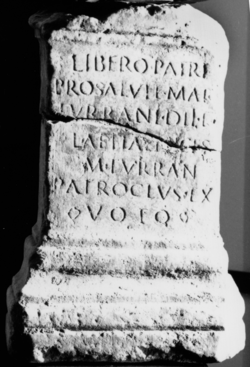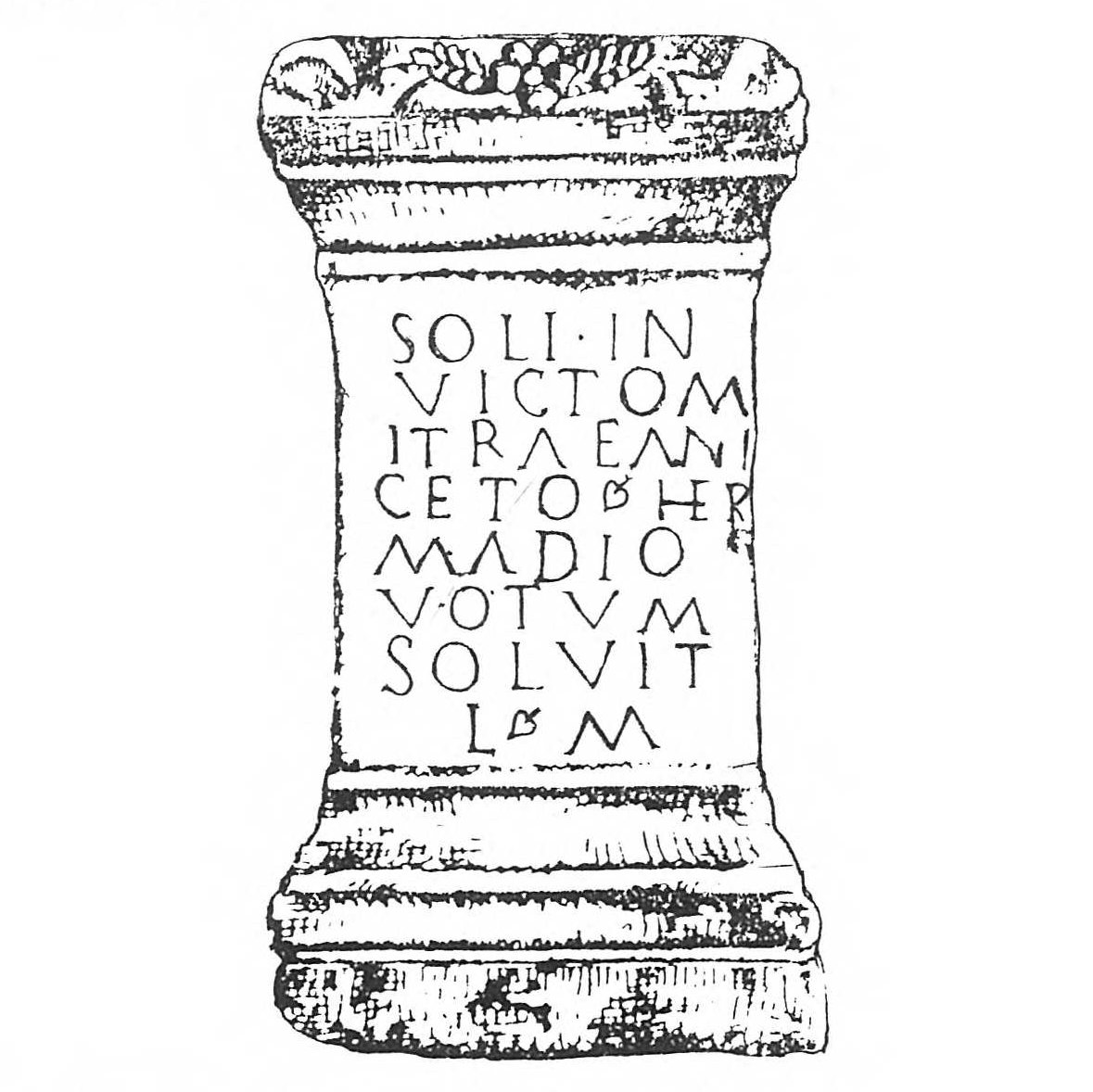
Hermadio
Lucius Flavius Hermadion
Hermadio's inscriptions have been found in Dacian Tibiscum and Sarmizegetusa, as well as in Rome.
Biography
of Hermadio
TNMP 117
I would like to contribute to the further expounding of this thought with gathering the data referring to a person who may have had a role in the spread — or even more also in the creation — of the cult of Mithras.
The name of a certain Hermadio in known from two Mithras inscriptions in Dacia. Judging from one of the remains this person is known to have been a slave doing economic work act(or):
1/ CIMRM 2146 - Sarmizegetusa:
2/ CIMRM 2153 - Tibiscum:
The inscriptions share a very important and similar feature: Hermadio actor who had erected them had found in necessary to present the god’s most important epitheton omans beside its Latin form (invictus) also in Greek (anicetus) and in Persian (nabarzes) trying to avoid any possible misunderstandings for sure, while stressing the accuracy of the content of the attribute translated into Latin.
The fact that Hermadio actor had lived in a familia in which the usage of Greek language had been of high importance is known on the strength of a further inscription:
3/ CIL III 1548 - Tibiscum:
According to this not only further persons with a Greek name appear among the members of M. Turranius Dil.’s familia (Patroclus, Nice), but also the possessive case of the domina’s name fits the Greek inflection even though the text in Latin (Nice > Nices). — What is more also an inscription from Apulum must be a proof of the religious life of the very same family:
4/ CIMRM 1193 - Apulum:
In connection with that not only the fact that the bearers of the Turranius name had been connected to the Mithras worship (or rather to the believers of Mithras) in many towns of Dacia (Apulum, Tibiscum, Sarmizegetusa) seems to be important, but also the fact that the members of this familia had carried on a wide-spread economic activity with different officers (actor, conductores) in a leading position.
Returning back to the role played in the cult of Mithras by the characters appearing on the inscriptions quoted above, the activity of Hermadio named on the relics No. 1-2 seems to be the most important. Namely, the use of the attributes of anicetus and nabarzes (most of all because of their rareness) refers to a person possessing an above-average knowledge about the notions of the cult. That’s why the peculiar wording of a sculpture’s inscription in Rome is striking:
5/ CIMRM 591 - Rome:
It is the god himself who speaks on the inscription, which obviously could have happened only in the case of privileged persons. But even more, Merkelbach was right to notice the representation of the original Persian gesture —throwing a kiss— connected to the expression of Nama = Hi! in the representation of the sculpture. He consideres it to be part of the initiation ceremony.
Now the question is whether Hermadio actor of the Dacian inscriptions (No. 1, 2) can be connected to L. FI. Hermadion appearing on the sculpture in Rome. — The same theophor name, the employment of the rarely used Greek and Persian concepts (anicetus, nabarzes, Nama) represented on each of the three inscriptions, and the characteristic feature of the relic in Rome bearing the own words of the god —certainly for the sake of one of his very important adeptuses— all back up the supposition of a direct connection although it seems to be questioned by the following condition: while a person with one name only —certainly with the status of a slave— is mentioned in Dacia, somebody with three names — thus a person of a free status — is known from Rome.
But the seriousness of this undoubtedly existing uncertainty is greatly belittled by the inscription from Tibiscum quoted ad No. 3 above, on which one of the members of the Dacian M. Turranius Dil.’s familia — maybe the domina — bears the name of Flavia Aelia Nice. If not more, but the fact, that the Flavius family name had been used in the close family and economic circle to which Hermadio actor erecting the Dacian inscriptions (No. 1, 2) belonged to, is assured by this reasoning. It follows from the foregoing — even if not totally for sure — that the servus Hermadio actor known from Tibiscum and Sarmizegetusa could have been identical with L. Flavius Hermadion mentioned in Rome, as a libertus.
A further relic is known, too, by which perhaps the erector of the Dacian remains can be directly connected to the one of the Mithras adaptus in the city of Rome:
6/ ILJug 2, 1145 = Toth, AddM 13. - Poetovio:
This altar — not accidentally for sure — comes from one of the most important centres of Mithras’ cult, which had been one of the leading economic centres of the Danubian provinces as well. Poetovio had been a transit station concerning any economic connection between the city of Rome and Illyricum: also acting as a go-between in the religious and spiritual connections of Rome and the region of Pontus at the same time.
The Mithraeum I and Mithraeum II in Poetovio had been furnished by the slaves and freedmen of the publicum portorium Illyrici. A manyfolded personal relationship had been proven among them by E. Will and R. Merkelbach. The two bases erected to worship Cautes and Cautopates had stood there. They had been consecrated 'in memoriam' a certain Hyacinthus. This feature is unusual on religious inscriptions. Hyacinthus has earlier been supposed to have been one of the founding 'prophets' of the cult of Mithras. In case Hermadio actor of the Dacian relics could be identified with the Roman and Poetovian Flavius Harmadio(n) the inscriptions quoted above could be put into a logical order. The elemental condition of this relatonship is a chronological examination of the four relics in question (No. 1-2, 5 and 6).
The first names represented on the inscriptions can be used as a starting point to set up a chronological order. Thus following the above order the following exact chronological points of reference arise:
No. 1 - judging from its epigraphy it is of the same age as No. 2 (Comp. Note 9)
No. 2 - terminus post quem: 117/138 (Aelius)
No. 3 - terminus post quem: 117/138 (Aelius)
No. 4 - similar to the above mentioned ones because of the presence of the Turranii
No. 5 - terminus post quem: 69/96 (Flavius), but in case the name of Flavius really is in connection with FI. Aelia Nice's name (no. 3) then 117/138.
No. 6 - terminus post quem: 69/96 (Flavius), but if the two Felix (liberti) are equal then terminus ante quem: 164/180.
According to that the quoted inscriptions fit exactly the same period of time. The period between the age of Hadrian and the markomannic wars after the middle of the 2nd cent, had been the time of the formation and spread of the Western cult of Mithras. The founding 'prophets' and missionary 'apostles' had been busy in this half century. I reckon to recognize the Dacian Hermadio actor as one of them.
—Tóth (1992) A Dacian 'Apostle' of the cult of Mithras?
References
- Epigraphic Database Heidelberg. Altar of Sarmizegetusa by Hermadio in EDH
- Epigraphic Database Heidelberg. Altar 2 of Tibiscum by Hermadio in EDH
- Epigraphic Database Heidelberg. Altar by Hermanio of Poetovio in EDH
- Epigraphik-Datenbank Clauss / Slaby. Altar of Sarmizegetusa by Hermadio in EDCS
- Epigraphik-Datenbank Clauss / Slaby. Altar 2 of Tibiscum by Hermadio in EDCS
- Epigraphik-Datenbank Clauss / Slaby. Altar by Hermanio of Poetovio in EDCS
- Epigraphik-Datenbank Clauss / Slaby. Altar of Hermadio from Tibiscum in EDCS
- István Tóth (1992) A Dacian 'Apostle' of the cult of Mithras?
Mentions
Altar 2 of Tibiscum by Hermadio
TNMM 580
This altar was erected by Hermadio, who also signed other monuments in Dacia and even in Rome.
Altar by Hermanio of Poetovio
TNMM 581
A certain Hermanio has been identified in the dedication of several monuments in different cities in Dacia and even in Rome.
Altar of Hermadio from Tibiscum
TNMM 579
This altar was erected by Hermadio, who also signed other monuments in Dacia and even in Rome.
Altar of Sarmizegetusa by Hermadio
TNMM 578
This altar was erected by Hermadio, who also signed other monuments in Dacia and even in Rome.
Mithras petrogenitus from Villa Giustiniani
TNMM 124
Mithras rock-born from Villa Giustiniani was holding a bunch of grapes in its raised right hand instead of a torch, probably due to a restoration.






Comments
Add a comment